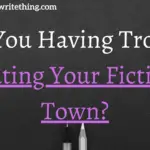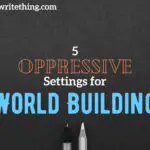
- The Action Scene
- The 1-2-3 Punch Scene
- The Vulnerable Scene
- The BIG Loss
One of the best ways to develop your characters and reveal who they REALLY are deep down to your readers is to put them into specific situations and then allow your readers to see who they are without just telling them boringly.
Case and point: Instead of saying he is mean and arrogant, you write that “he yelled at his sister for leaving the roast in too long and he bragged to everyone, he got the chance to, about making varsity this year and took up the whole conversation talking about his football throw and how far and accurate he could throw. He wasn’t interested in hearing anything about them at all. In fact, any time they would try to chime in, he would interrupt them or zone out until he could say something else about himself.”
By writing a scene and dialogue that shows who your character is, you never have to actually talk about their personality at all.
Your readers will be able to see it. Your readers will love you for this and they won’t even know you’re doing it. It gets amusing figuring out how to write their actions or inactions into scenes that show what you are desiring to tell.
Just a Tip before getting started: Take a few minutes, sit down, and write out specifically what you want to reveal about your character through these scenes. For example: arrogant, funny, secretive, aloof, gruff. You can use these scenes on your protagonist, antagonist, secondary characters, villains, pedestrians, temporary characters, any character you can think of.
Now on with it.

# 1 Write The Action Scene
The action scene is an easy setup and an easy way to reveal character quickly.
The key secret to a well set up action scene that reveals character is putting the character against a problem where they must take action or decide not to take action but either way their action or inaction reveals who they are deep down as a character.
Important note: It’s not only the action they take that defines to the reader what their true nature is as a character.
It’s also the actions they don’t take.
Not only that, but you can also reveal character by how they make the decision as you write.
- Are they meticulous and plan everything out?
- Or are they quick to action and don’t plan anything out?
- Does this lead to further problems by taking too long to plan things out?
- Or by acting to rashly to quickly do they create self-destructive problems?
- Does the character learn as they go and approach problems differently based on past events you took them through?
- Or do they keep making the same mistakes?
- Are they cowardly and take no action at all by running or leaving the problem for others to solve?
Writing task: Take a few minutes to develop a problem and write out how the character works their way through the problem or problems and be sure to write character traits you want to portray to your reader by showing how the character would or wouldn’t take action.
# 2 Write The 1-2-3 Punch Scene
The 1-2-3 Punch scene is called “the 1-2-3 Punch Scene,” because it happens REAL fast. If you blink you might miss it. (So don’t blink…Okay, do blink)
Your reader won’t know that you’ve done it but all within one paragraph usually you’ll have divulged very specific character traits that run down through your character’s core in a matter of a minute or two.
Let’s use the movie “Guardians of the Galaxy” as an example, and we’ll use Ronin the antagonist.
It happens really fast but in the first few moments, we see Ronin as he is going through ritualistic ceremonies.
You can tell they happen daily.
In an instant, we see that he is dedicated, determined, no-nonsense, and disciplined down to his core. And then immediately following we see him harshly judge a man and execute him with his own hammer. We watch his victim’s blood flow into his bathing chamber.
We see his cruelty and how he judges an individual based on his ancestor’s actions without any thought to see how the person is individual.
We see that he’s determined, extremely cruel, and prone to violence, and desires genocide. In a matter of minutes, we know this character. We know that he is cruel and that he will stop at nothing to carry out his cause of vengeance.
This is, in essence, the 1-2-3 Punch. In as quick as a paragraph you can have your character carry out 1-2 or 3 quick actions that display who that character is down to their core and it all happens as quick as a punch and your audience suddenly has a large sense of who that character is. To execute this type of scene well you need to decide a couple of character traits you want your character to have.
Let’s make an example: I have a Protagonist named Jim. I want to portray that Jim is kind, caring, and charitable.
Let’s say Jim’s widowed Aunt stays with him and his son.
She comes home one day and realizes she forgot the butter. Jim hears her exclaim her disappointment and he quickly jumps up and says “Don’t worry about it Auntie, I’ll run out and get your butter for you so that you don’t have to run back in town.” He says it with a big smile of course and a great attitude about the whole thing whistling as he’s off on his way to the store.
While waiting in line to buy the butter the person in front of him is a dollar or two short. Jim quickly says “Oh, let me get that for you” and smiles at the distraught stranger while digging in his pocket for two dollars.
In a short paragraph, we have seen that Jim is kind, caring, and charitable. We didn’t have to SAY “Jim is kind, caring, and charitable.” We used a scene to let the reader see it for themselves.
Want to get paid to write? Check out Writing Paychecks
- There is a simple method over 30,000 people use to get paid for freelance writing online.
- Opportunities can get started in just minutes a day, all from your home couch.
- It’s easy to get started! No previous experience or degree required to start.
- Exclusive job listings for writers, updated daily.
Check out Writing Paychecks to see if you can start getting paid to write today.

# 3 Write The Vulnerability Scene
Have you ever been reading a short story or novel and you start to notice that there is absolutely nothing wrong with the main character or their antagonist?
If you notice, you’ll see that you start to lose interest and resonate less and less with the “perfect” character. This is because, in real life, we know there no such thing as a perfect person. And if their life was perfect, it would be boring. This is why it’s important to have the Vulnerability Scene.
This scene is exactly how it sounds. You have to make your character a little vulnerable in some way. You can go as far as you want with it, but you have to show that the character isn’t perfect and that they have consequences just like people in the real world. Most often it doesn’t have to be some big unheard-of thing. In actuality, this can work best if it is some quick notice of something that could be considered “normal” or small.
For example: Our Sheriff drinks most nights when he’s off duty (and sometimes on duty.) The mailman sometimes reads our letters before delivering them. The DMV worker has an expired license but drives anyway. It could be anything and it could be small or a big deal, but if your characters are going to be believable you have to show some vulnerability so that readers can relate to them a little.
A sure-fire way to become a better writer is to start a blog of your own in a niche you are passionate about: All You Need to Know To Start a Blog Here!
Try Grammarly, The Free tool that should be in every writer’s toolbelt.
# 4 Write The BIG Loss
Another way to write a scene that shows who the character is is to put your character through loss. The loss doesn’t have to be a big deal to you, but whatever it is that they lost, it MUST be a big deal to them. The more strange the loss is and how much it hurts the character you write emotionally the more readers can see what is actually important to the character and see what they are like as you write.
If you write your character losing a family member and is only a little sad, but they lose an animal and sob for weeks we can see what is important to this person. Another good example you can write would be a character losing their job and not caring, but their car gets a scratch on it and you write them going into an unforeseeable rage. As we see what the character doesn’t care about and what they care most about in their heart we can see their heart and the core beliefs of the character as we write.
Like I said the loss doesn’t have to always be something that most people would see as a big deal. It could be something you write that you don’t consider to be a big deal, but the fact that it is a big deal to them helps the reader see more and more of who this person is at their core self.
On the flip side, you can use the BIG loss scene in reverse. Write them through a scenario where they experience a loss that most of society would consider a big deal but the fact that you write the character doesn’t, shows who they are as a person and a key part of their character and maybe even an important part of your plot. Make them lose a father, mother, brother, or sister and make them not care and your readers will be lead to curiosity why they don’t care.
Play with the big loss scenario and use it both ways to show what is and isn’t important to your character.
Thanks for reading! Now go write something!
In the comments share with us your character and what you’re going to write to Show and NOT tell what your character’s traits are.
Want to get paid to write? Check out Writing Paychecks
- There is a simple method over 30,000 people use to get paid for freelance writing online.
- Opportunities can get started in just minutes a day, all from your home couch.
- It’s easy to get started! No previous experience or degree required to start.
- Exclusive job listings for writers, updated daily.
Check out Writing Paychecks to see if you can start getting paid to write today.





Need a Cheaper Plan? Try DreamHost.
If you enjoy How To Write 4 Scenes That Reveal Who Your Character Is Seamlessly, Storytelling, and writing in general, you might love owning a domain of your own where you can write about it? Ever want to own your own domain name (Yourname.com)?
Bluehost hosts your blog so that you can own your domain and make money blogging. Check them out only if you’re interested in making money blogging; otherwise, go for a free blog instead 🙂
Try Grammarly, The Free tool that should be in every writer’s toolbelt.
How To Write 4 Scenes That Reveal Who Your Character Is Seamlessly
Check this out.
What are you going to write next?
Did reading this post inspire you to write?
Did this post inspire you to edit and write any scenes?
After reading this what scenes will you try to write?
Write to us in the comments below!
Other Popular Posts you might enjoy:
5 Tricks How to Hide Your Villain Right Before Their Eyes
10 Tips How to Write Villains that Play Mind Games with Their Victims
4 Tips How to Write your Character Hitting Rock Bottom
10 Toxic Bad Habits That’ll Crush Your Fictional Character’s Relationships
How to Write From Your Villain’s Mind.
How To Write 4 Scenes That Reveal Who Your Character Is Seamlessly
Psychopath: How to Write The Perfect Psychopath
8 Tips How to Write the Perfect Sociopath
Fictional Characters: 28+ Bad Habits to Introduce to Your Fictional Characters
List of 10 Weapons for Fictional Characters
List of 10 Bad Habits Fictional Characters Need Help Breaking
Resources:
How to Start a Blog in 11 Simple Easy Steps in 2020
6 Easy Practical Steps to Becoming a Better Writer in 30 Days or Less
What Should I Write About: 22 Writing Prompts to Give You BIG IDEAS
Make sure your posts are readable. Use this readability score check
Want to check out a writer’s community to test your writing and get feedback?
Check out these FREE trial resources from Amazon for when you work from home (or are stuck at home 🙂 )
Free Prime Membership Trial:
Try Amazon Prime 30-Day Free Trial
Try Prime Discounted (Free Trial)
Make your Free Amazon Wedding Registry:
Create an Amazon Wedding Registry
Free Baby Registry:
Shop Amazon – Create an Amazon Baby Registry





Thank you for this article! I love that it’s not just informative, it’s something concrete writers can actually work with!!
You’re welcome, Ariffa! I’m glad you like it and can work with it!
Thank you for this and taking the time to state clear examples.
Could you please share some tips for the “opening scene” in a story
You’re very welcome and we are glad you enjoyed it 🙂
That is a great idea! We will add it to the list. Thank you for the thoughtful question.
“This website really has all of the info I wanted about this subject and didn’t know who to ask.”
We are glad to hear you have enjoyed your time here 🙂